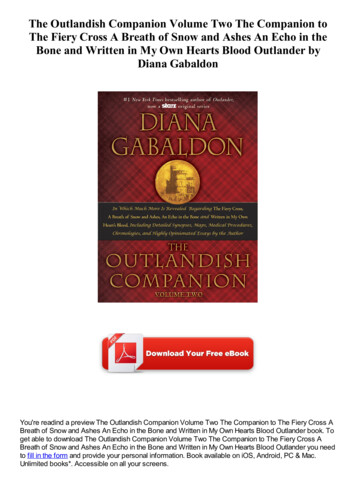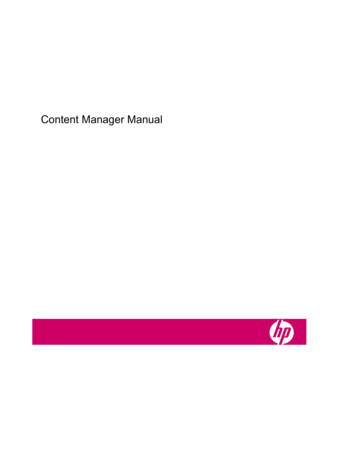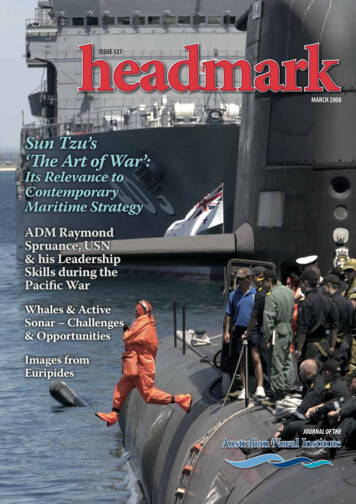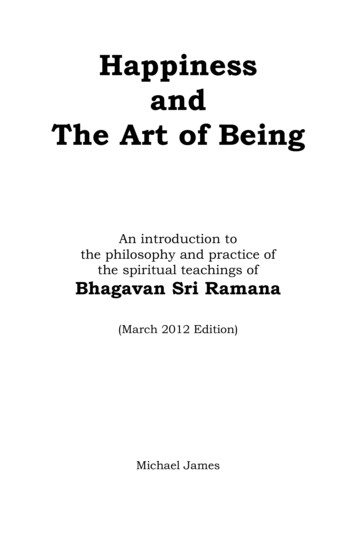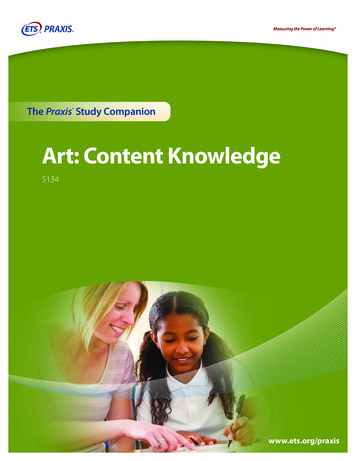
Transcription
The Praxis Study CompanionArt: Content Knowledge5134www.ets.org/praxis
Welcome to the Praxis Study CompanionWelcome to The Praxis Study CompanionPrepare to Show What You KnowYou have been working to acquire the knowledge and skills you need for your teaching career. Now you areready to demonstrate your abilities by taking a Praxis test.Using the Praxis Study Companion is a smart way to prepare for the test so you can do your best on test day.This guide can help keep you on track and make the most efficient use of your study time.The Study Companion contains practical information and helpful tools, including: An overview of the Praxis tests Specific information on the Praxis test you are taking A template study plan Study topics Practice questions and explanations of correct answers Test-taking tips and strategies Frequently asked questions Links to more detailed informationSo where should you start? Begin by reviewing this guide in its entirety and note those sections that you needto revisit. Then you can create your own personalized study plan and schedule based on your individual needsand how much time you have before test day.Keep in mind that study habits are individual. There are many different ways to successfully prepare for yourtest. Some people study better on their own, while others prefer a group dynamic. You may have more energyearly in the day, but another test taker may concentrate better in the evening. So use this guide to develop theapproach that works best for you.Your teaching career begins with preparation. Good luck!Know What to ExpectWhich tests should I take?Each state or agency that uses the Praxis tests sets its own requirements for which test or tests you must take forthe teaching area you wish to pursue.Before you register for a test, confirm your state or agency’s testing requirements at www.ets.org/praxis/states.How are the Praxis tests given?Praxis tests are given on computer. Other formats are available for test takers approved for accommodations (seepage 36).The Praxis Study Companion2
Welcome to the Praxis Study CompanionWhat should I expect when taking the test on computer?When taking the test on computer, you can expect to be asked to provide proper identification at the testcenter. Once admitted, you will be given the opportunity to learn how the computer interface works (how toanswer questions, how to skip questions, how to go back to questions you skipped, etc.) before the testing timebegins. Watch the What to Expect on Test Day video to see what the experience is like.Where and when are the Praxis tests offered?You can select the test center that is most convenient for you. The Praxis tests are administered through aninternational network of test centers, which includes Prometric Testing Centers, some universities, and otherlocations throughout the world.Testing schedules may differ, so see the Praxis web site for more detailed test registration information at www.ets.org/praxis/register.The Praxis Study Companion3
Table of ContentsTable of ContentsThe Praxis Study Companion guides you through the steps to success1. Learn About Your Test.5Learn about the specific test you will be taking2. F amiliarize Yourself with Test Questions.9Become comfortable with the types of questions you’ll find on the Praxis tests3. Practice with Sample Test Questions. 13Answer practice questions and find explanations for correct answers4. Determine Your Strategy for Success. 20Set clear goals and deadlines so your test preparation is focused and efficient5. Develop Your Study Plan. 23Develop a personalized study plan and schedule6. Review Study Topics. 27Detailed study topics with questions for discussion7. Review Smart Tips for Success. 34Follow test-taking tips developed by experts8. Check on Testing Accommodations. 36See if you qualify for accommodations to take the Praxis test9. Do Your Best on Test Day. 37Get ready for test day so you will be calm and confident10. Understand Your Scores. 39Understand how tests are scored and how to interpret your test scoresAppendix: Other Questions You May Have . 41The Praxis Study Companion4
Step 1: Learn About Your Test1. Learn About Your TestLearn about the specific test you will be takingArt: Content Knowledge (5134)Test at a GlanceTest NameArt: Content KnowledgeTest Code5134Time2 hoursNumber of Questions120FormatSelected-response questionsTest DeliveryComputer deliveredContent CategoriesI.IIIArt MakingA. GeneralB. Media and ProcessesII. Historical and Theoretical Foundationsof ArtApproximateNumber ofQuestionsApproximatePercentage ofExamination76156164%13%51%4436%A. Materials and Processes in an Art6–7Historical Context5%B. The Western Tradition in Art History17–1815%C. Art Beyond the Western Tradition97%D. Responding to Art119%About This TestArt: Content Knowledge measures whether entry-level art teachers have the standards-relevant knowledge,skills, and abilities deemed necessary for beginning professional practice. The test is intended primarily forindividuals completing teacher training programs who plan to become art teachers. Candidates typically havecompleted a bachelor’s degree program in art or art education. The test questions focus on concepts that areconsidered central to the study of art, measuring knowledge of art making and the historical and theoreticalfoundations of art. Images are included on the screen with some of the questions.The test may contain some questions that will not count toward your score.The Praxis Study Companion5
Step 1: Learn About Your TestTest SpecificationsTest specifications in this chapter describe the knowledge and skills measured by the test. Study topics to helpyou prepare to answer test questions can be found on page 27.I.Art MakingA.GeneralThe candidate:1. Knows and understands the elements of art andprinciples of visual organization (i.e., principles ofdesign) as applied to two-dimensional and threedimensional mediaa. identifies elements and principles of design invisual stimulib. explains relationships of elements toprinciplesc. distinguishes uses of elements and principlesin two-dimensional and three-dimensionalart2. Knows and understands various historicalmethods (e.g., golden mean, hierarchicalorganization, perspective) and contemporaryapproaches (juxtaposition, appropriation,transformation, etc.) to creating arta. defines/identifies both historical andcontemporary methodsB.Media and ProcessesThe candidate:1. Knows and understands safety, environmental,and storage issues related to the use of artmaterials (e.g., clay dust, lead pigments, safetylabel information) and art processes (e.g., cutting,etching, spraying)a. identifies dangerous materials and theireffectsb. categorizes dangerous materials and theireffectsc. describes proper ventilation, storage, anddisposal procedures based on the mediumd. demonstrates knowledge of MSDS sheetse. demonstrates understanding of safetyprocedures and precautions for using artists’materials and toolsf.demonstrates knowledge of health issuesrelated to the use of artists’ materials andtools (e.g., toxicity)2. Knows and understands how to use a variety ofdrawing, painting, and printmaking materials andprocessesa. identifies characteristics of materialsb. identifies similarities and differences amongmaterialsc. knows vocabulary related to drawing,painting, and printmaking materials andprocessesd. describes drawing, painting, and printmakingprocessese. solves problems and evaluates possiblesolutionsf.compares materials and techniques, andanalyzes the compatibility of materials andtechniquesg. recognizes or identifies processes throughreproductions3. Knows and understands how to use digitalphotography and image processesa. demonstrates basic camera knowledge(camera parts, vocabulary)b. demonstrates knowledge of common editingand imaging software (e.g., cropping, basicmanipulation, resizing)c. demonstrates knowledge of uploading,downloading, storing common file types suchas .jpg and .tif, transferring, and printingimagesd. knows and understands the process ofcreating digital images4. Knows and understands materials, tools, andprocesses for videography, filmmaking, andinstallationsa. identifies/describes materials, tools, andprocesses for videography, filmmaking, andinstallations5. Knows and understands how to use sculpturalmaterials and processesa. identifies characteristics of materialsb. identifies similarities and differences amongmaterialsc. knows vocabulary related to sculpturalmaterials and processesThe Praxis Study Companion6
Step 1: Learn About Your Testd. describes sculptural processese. solves problems and evaluates possiblesolutionsf.II.Historical and Theoretical Foundation ofArtA.compares materials and techniques, andanalyzes the compatibility of materials andtechniquesThe candidate:1. Knows and understands the following materialswithin an art historical context: painting, drawing,printmaking, sculpture, architecture,photography, fiber arts, and craftsg. recognizes or identifies processes throughreproductions6. Knows and understands how to use a variety offiber art materials and processes (e.g., weaving,basketry, paper making, jewelry making,processes based on sewing)a. identifies characteristics of materials,processes, and techniques within an arthistorical contexta. identifies characteristics of materialsb. identifies similarities and differences amongmaterials, processes, and techniques (e.g.,evolution over time)b. identifies similarities and differences amongmaterialsc. knows vocabulary related to two-dimensionaland three-dimensional media and processeswithin an art historical contextc. knows vocabulary related to fiber materialsand processesd. describes fiber processese. solves problems and evaluates possiblesolutionsf.compares materials and techniques, andanalyzes the compatibility of materials andtechniquesg. recognizes or identifies processes throughreproductions7. Knows and understands the physical aspects andeffective ways of presenting artwork for displaypurposes (e.g., cutting mats, display boards)a. identifies and describes methods ofmounting and matting work in waysappropriate to the mediumb. identifies and describes methods ofdisplaying three-dimensional workc. describes appropriate ways of usingexhibition spacesMaterials and Processes in an ArtHistorical Contextd. recognizes or identifies processes within anart historical context through reproductionsB.The Western Tradition in Art HistoryThe candidate:1. Recognizes stylistic traits of art and architecturefrom each of the following time periods:Prehistory; Egypt and the Ancient Near East;Ancient Greece and Rome; Early Christian,Byzantine, and Medieval periods; theRenaissance; the Baroque; 18th through 20thcenturies in Europe and North America; andcontemporary arta. identifies the styles of works of art andarchitectureb. categorizes art and architecture according tostyle and/or periodc. identifies major works of art and architectureby title, style, and/or artist, as appropriated. analyzes/explains the influence of arthistorical periods or schools on later worke. analyzes compositional elements andprinciples of design in works of art andarchitecturef.The Praxis Study Companionrecognizes the impact of major artistic andtechnological innovations (e.g., linearperspective, the invention of the camera, theinvention of oil and acrylic paints) on thestylistic traits of art7
Step 1: Learn About Your Test2. Knows and understands the content, context,and/or purpose of art and architecture from eachof the following time periods: Prehistory; Egyptand the Ancient Near East; Ancient Greece andRome; Early Christian, Byzantine, and Medievalperiods; the Renaissance; the Baroque; 18ththrough 20th centuries in Europe and NorthAmerica; and contemporary arta. explains the purposes of works of art fromvarious time periodsb. decodes/analyzes the narrative or intendedcontent of a work of artc. analyzes/explains the interrelationshipsbetween art and social factors, culturalcontext, and eventsC.c. explains how the context in which a work ofart is created conveys information aboutvarious lifestyles and belief systems (e.g., howMesoamerican pyramids illuminate life andculture)d. evaluates information about art and artistsfrom various sourcesD.Responding to ArtThe candidate:1. Knows and understands the major theories of artand aesthetics (e.g., formalism, expressionism,deconstructivism, and representationalism)a. recognizes the major characteristics of varioustheories of art and aestheticsd. explains the impact of major artistic andtechnological innovations on the content,context, and purposes of art (e.g., linearperspective, the invention of the camera, theinvention of oil and acrylic paints)b. distinguishes among the major theories of artand aestheticse. evaluates information about art and artistsfrom various sourcesd. interprets and evaluates works of art basedon theories of art and aesthetics (as opposedto personal opinion)Art Beyond the Western TraditionThe candidate:1. Knows and understands the general visualcharacteristics of art and architecture from Asia,Africa, the Americas, and the South Pacific regiona. classifies works of art and architecture byregions/culturesb. describes/analyzes works of art andarchitecture using compositional elementsand principles of designc. describes/analyzes the interrelationshipsbetween art from beyond the Westerntradition and art from the Western traditiond. identifies major works of art and architectureby title, style, and/or artist, as appropriate2. Knows and understands the general content,context, and purposes of art from Asia, Africa, theAmericas, and the South Pacific regionc. compares and contrasts the differences/similarities among theories of art andaesthetics2. Knows and understands the relationshipbetween art and critical responsea. demonstrates knowledge of critical reactionsto well-known works and/or art movementsb. recognizes/uses multiple viewpoints inexamining a work of art (e.g., multipleviewpoints can be applied to the same workof art; visual or written analysis; looking atvarious analyses of works in history; “lenses”)c. recognizes the way personal experienceaffects interpretation of art (understandingthat each person’s experiences will affect howthat person sees art)d. recognizes how meaning is created in art(e.g., through symbols, iconography, formalelements and principles)a. explains the content and/or purpose (asappropriate) of frequently referenced worksof art from various locations and culturesb. identifies the general role of a work of art inits culture (e.g., celebration, ritual orceremony, historical documentation)The Praxis Study Companion8
Step 2: Familiarize Yourself with Test Questions2. Familiarize Yourself with Test QuestionsBecome comfortable with the types of questions you’ll find on the Praxis testsThe Praxis assessments include a variety of question types: constructed response (for which you write aresponse of your own); selected response, for which you select one or more answers from a list of choices ormake another kind of selection (e.g., by clicking on a sentence in a text or by clicking on part of a graphic); andnumeric entry, for which you enter a numeric value in an answer field. You may be familiar with these questionformats from taking other standardized tests. If not, familiarize yourself with them so you don’t spend timeduring the test figuring out how to answer them.Understanding Computer-Delivered QuestionsQuestions on computer-delivered tests are interactive in the sense that you answer by selecting an optionor entering text on the screen. If you see a format you are not familiar with, read the directions carefully. Thedirections always give clear instructions on how you are expected to respond.For most questions, you respond by clicking an oval to select a single answer from a list of answer choices.However, interactive question types may also ask you to respond by: Clicking more than one oval to select answers from a list of choices. Typing in an entry box. When the answer is a number, you may be asked to enter a numerical answer.Some questions may have more than one place to enter a response. Clicking check boxes. You may be asked to click check boxes instead of an oval when more than onechoice within a set of answers can be selected. Clicking parts of a graphic. In some questions, you will select your answers by clicking on a location (orlocations) on a graphic such as a map or chart, as opposed to choosing your answer from a list. Clicking on sentences. In questions with reading passages, you may be asked to choose your answers byclicking on a sentence (or sentences) within the reading passage. Dragging and dropping answer choices into targets on the screen. You may be asked to select answersfrom a list of choices and drag your answers to the appropriate location in a table, paragraph of text orgraphic. Selecting answer choices from a drop-down menu. You may be asked to choose answers by selectingchoices from a drop-down menu (e.g., to complete a sentence).Remember that with every question you will get clear instructions.Perhaps the best way to understand computer-delivered questions is to view the Computer-delivered TestingDemonstration on the Praxis web site to learn how a computer-delivered test works and see examples ofsome types of questions you may encounter.The Praxis Study Companion9
Step 2: Familiarize Yourself with Test QuestionsUnderstanding Selected-Response QuestionsMany selected-response questions begin with the phrase “which of the following.” Take a look at this example:Which of the following is a flavor made from beans?(A) Strawberry(B) Cherry(C) Vanilla(D) MintHow would you answer this question?All of the answer choices are flavors. Your job is to decide which of the flavors is the one made from beans.Try following these steps to select the correct answer.1) L imit your answer to the choices given. You may know that chocolate and coffee are also flavors madefrom beans, but they are not listed. Rather than thinking of other possible answers, focus only on the choicesgiven (“which of the following”).2) E liminate incorrect answers. You may know that strawberry and cherry flavors are made from fruit andthat mint flavor is made from a plant. That leaves vanilla as the only possible answer.3) V erify your answer. You can substitute “vanilla” for the phrase “which of the following” and turn thequestion into this statement: “Vanilla is a flavor made from beans.” This will help you be sure that your answeris correct. If you’re still uncertain, try substituting the other choices to see if they make sense. You may wantto use this technique as you answer selected-response questions on the practice tests.Try a more challenging exampleThe vanilla bean question is pretty straightforward, but you’ll find that more challenging questions have asimilar structure. For example:Entries in outlines are generally arranged accordingto which of the following relationships of ideas?(A) Literal and inferential(B) Concrete and abstract(C) Linear and recursive(D) Main and subordinateYou’ll notice that this example also contains the phrase “which of the following.” This phrase helps youdetermine that your answer will be a “relationship of ideas” from the choices provided. You are supposed to findthe choice that describes how entries, or ideas, in outlines are related.Sometimes it helps to put the question in your own words. Here, you could paraphrase the question in this way:“How are outlines usually organized?” Since the ideas in outlines usually appear as main ideas and subordinateideas, the answer is (D).The Praxis Study Companion10
Step 2: Familiarize Yourself with Test QuestionsQUICK TIP: Don’t be intimidated by words you may not understand. It might be easy to be thrown by wordslike “recursive” or “inferential.” Read carefully to understand the question and look for an answer that fits. Anoutline is something you are probably familiar with and expect to teach to your students. So slow down, anduse what you know.Watch out for selected-response questions containing “NOT,” “LEAST,” and “EXCEPT”This type of question asks you to select the choice that does not fit. You must be very careful because it is easyto forget that you are selecting the negative. This question type is used in situations in which there are severalgood solutions or ways to approach something, but also a clearly wrong way.How to approach questions about graphs, tables, or reading passagesWhen answering questions about graphs, tables, or reading passages, provide only the information that thequestions ask for. In the case of a map or graph, you might want to read the questions first, and then look at themap or graph. In the case of a long reading passage, you might want to go ahead and read the passage first,noting places you think are important, and then answer the questions. Again, the important thing is to be sureyou answer the questions as they refer to the material presented. So read the questions carefully.How to approach unfamiliar formatsNew question formats are developed from time to time to find new ways of assessing knowledge. Tests mayinclude audio and video components, such as a movie clip or animation, instead of a map or reading passage.Other tests may allow you to zoom in on details in a graphic or picture.Tests may also include interactive questions. These questions take advantage of technology to assessknowledge and skills in ways that standard selected-response questions cannot. If you see a format you arenot familiar with, read the directions carefully. The directions always give clear instructions on how you areexpected to respond.QUICK TIP: Don’t make the questions more difficult than they are. Don’t read for hidden meanings or tricks.There are no trick questions on Praxis tests. They are intended to be serious, straightforward tests ofyour knowledge.Understanding Constructed-Response QuestionsConstructed-response questions require you to demonstrate your knowledge in a subject area by creatingyour own response to particular topics. Essays and short-answer questions are types of constructed-responsequestions.For example, an essay question might present you with a topic and ask you to discuss the extent to which youagree or disagree with the opinion stated. You must support your position with specific reasons and examplesfrom your own experience, observations, or reading.Take a look at a few sample essay topics: “ Celebrities have a tremendous influence on the young, and for that reason, they have a responsibility toact as role models.” “ We are constantly bombarded by advertisements—on television and radio, in newspapers andmagazines, on highway signs, and the sides of buses. They have become too pervasive. It’s time to putlimits on advertising.” “ Advances in computer technology have made the classroom unnecessary, since students and teachersare able to communicate with one another from computer terminals at home or at work.”The Praxis Study Companion11
Step 2: Familiarize Yourself with Test QuestionsKeep these things in mind when you respond to a constructed-response question1) A nswer the question accurately. Analyze what each part of the question is asking you to do. If thequestion asks you to describe or discuss, you should provide more than just a list.2) A nswer the question completely. If a question asks you to do three distinct things in your response,you should cover all three things for the best score. Otherwise, no matter how well you write, you willnot be awarded full credit.3) A nswer the question that is asked. Do not change the question or challenge the basis of thequestion. You will receive no credit or a low score if you answer another question or if you state, forexample, that there is no possible answer.4) G ive a thorough and detailed response. You must demonstrate that you have a thoroughunderstanding of the subject matter. However, your response should be straightforward and not filledwith unnecessary information.5) R eread your response. Check that you have written what you thought you wrote. Be sure not toleave sentences unfinished or omit clarifying information.QUICK TIP: You may find that it helps to take notes on scratch paper so that you don’t miss any details. Thenyou’ll be sure to have all the information you need to answer the question.For tests that have constructed-response questions, more detailed information can be found on page 11.The Praxis Study Companion12
Step 3: Practice with Sample Test Questions3. Practice with Sample Test QuestionsAnswer practice questions and find explanations for correct answersComputer DeliveryThis test is available on computer. To illustrate what the computer-delivered test looks like, the following samplequestion shows an actual screen used in a computer-delivered test. For the purposes of this guide, samplequestions are provided as they would appear in a paper-delivered test.The Praxis Study Companion13
Step 3: Practice with Sample Test QuestionsSample Test QuestionsThe sample questions that follow illustrate the kinds ofquestions in the test. They are not, however, representative of theentire scope of the test in either content or difficulty. Answerswith explanations follow the questions.For the test, images appear as small thumbnail versions above orto the left of the question(s) they refer to. To expand an imagethumbnail, click on the plus sign in the lower right corner. Whilethe image is expanded, you will see a plus sign and a minus signthat allow you to zoom in and out. To close the image, click on the“x “in the upper right corner. You can open and close each imageas many times as you like.Directions: Each of the questions or incompletestatements below is followed by four suggested answers orcompletions. Select the one that is best in each case.Art Making1. Which of the following terms refers to the useof distortion to create the illusion of an objectextending into space? CNAC / MNAM / Dist. Réunion des MuséesNationaux / Art Resource, NY3. In the work shown above, Ernst anticipatedand manipulated which of the followingpostmodern design principles as a means ofconveying a sense of the irrational and theillogical?(A) Gazing(A) Cantilevering(B) Hybridity(B) Contrapposto(C) Appropriation(C) Sfumato(D) Juxtaposition(D) Foreshortening2. A triad on a color wheel can be described as(A) three analogous colors(B) three colors equally spaced apart(C) three colors of equal value(D) a complementary set4. Which of the following is the most reasonableaction to take for an artist whose workrequires the use of a specific hazardousproduct?(A) Finding a nontoxic product to use andadapting the art-making process asnecessary(B) Reading the product’s label andproceeding according to the labeldirections(C) Making sure no children are presentwhen using the product(D) Checking with a qualified toxicologistbefore using the material5. In storing printmaking supplies, it is importantto store which of the following materialsseparately from the others?(A) Acetic acid(B) Rosin powder(C) Nitric acid(D) SolventsThe Praxis Study Companion14
Step 3: Practice with Sample Test Questions6. Which of the following is most characteristicof gesture drawing?(A) An outline(B) Action and movement(C) Gradual shading(D) Carefully observed details7. A hard-edge painting is most likely to becharacterized by(A) an even, solid paint application(B) blurry color mixed on the painting’ssurface11. The term that best describes an artwork thatincorporates theatrical elements such as bodymovement, audience participation, music, andprojected images is(A) mimesis(B) installation art(C) performance art(D) digital collage12. Which of the following terms refers to potterythat has not been bisque fired?(A) Raku(C) scratchy brush marks clearly separated(B) Greenware(D) translucent multiple layers of paint(C) Terracotta(D) Stoneware8. Which of the following terms refers to theprocess of using thick applications of paint?(A) Scumbling(B) Alla prima(C) Impasto(D) Frottage9. Which of the following statements accuratelydescribes a JPEG compressed digitalphotograph?(A) The JPEG format is used only for colorphotos.(B) A JPEG compression alters theproportions of the original image byrearranging data.(C) A JPEG compression sharpens thedetails in an image.(D) The JPEG format compresses file size byselectively discarding data.13. Which of the following tools is LEAST likely tobe used in the process of creating a woodsculpture?(A) A rasp(B) A gouge(C) A lathe(D) An extruder14. In weaving, the vertical and horizontal threadsin a loom are called the(A) bobbin and quill(B) shuttle and paddle(C) ply and twist(D) warp and weft15. Fragile works of sculpture can be displayedmost securely by placing the works(A) in glass-paneled
photography, fiber arts, and crafts a. identifies characteristics of materials, processes, and techniques within an art historical context b. identifies similarities and differences among materials, processes, and techniques (e.g., evolution over time) c. knows vocabulary related to
